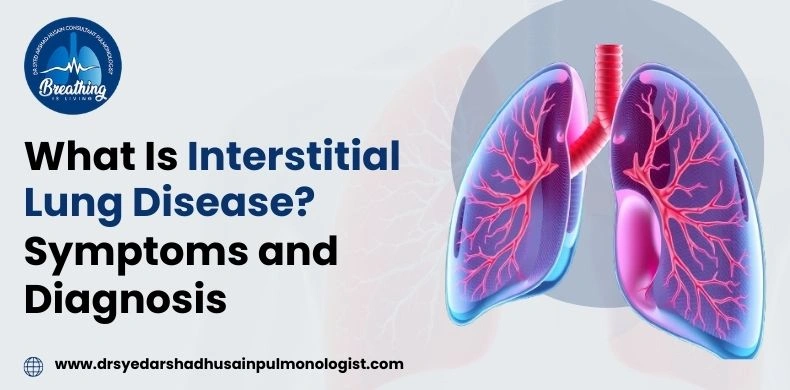Breathing should come and feel easy. But people with interstitial lung disease (ILD) often have to fight for every breath they take. This group of lung disorders can make daily tasks harder, lower life quality, and often goes unnoticed until the symptoms get too serious to ignore.
Patients at Al Zahra Hospital Dubai are treated by Prof. Dr. Syed Arshad Husain, a top consultant pulmonologist with more than 30 years of experience in the UK and UAE. He offers expert care in diagnosing and managing complex lung issues, including chronic interstitial lung disease.
If you want to know what ILD is, what it looks like, and how experts like Dr. Husain can assist, this explains the condition, its signs, and how it gets diagnosed.
Know more: Recurring Chest Infections: Is It Time to See a Pulmonologist?
What to Know About Interstitial Lung Disease
Tiny air sacs called alveoli make up the lungs, allowing oxygen to enter the bloodstream. Around these sacs is a thin tissue called the interstitium. With interstitial lung disease, this tissue gets inflamed or scarred. This causes stiffness and makes it difficult for oxygen to reach the blood.
Interstitial Lung Disease, or ILD, doesn�t describe just one condition. It covers over 200 disorders that harm the lung interstitium. Some types worsen, while others can impair lung function. Once fibrosis or scarring occurs, the damage can�t be undone. This makes it crucial to diagnose and address the condition.
Signs of Interstitial Lung Disease
A big problem with ILD is how its symptoms can be confused with milder problems like asthma or basic respiratory infections. Still, knowing interstitial lung disease symptoms can help people get treatment faster.
Common signs include:
- Constant Shortness of Breath � Starts during physical effort and later happens even when resting.
- Ongoing Dry Cough � A key symptom that doesn�t respond to standard treatments.
- Feeling Weak and Tired � Caused by less oxygen reaching the body.
- Chest Pain or Tightness � Breathing can bring discomfort or achiness in the chest.
- Unexpected Weight Loss � Sometimes appears as the illness gets worse.
- Swollen Fingertips � The tips of fingers may become larger, usually in the late stages of the condition.
You should know that interstitial lung disease symptoms might take a long time to show up. Ignoring them lets the condition worsen until the lungs face serious harm.
Know more: Cough-Variant Asthma: More Than Just a Lingering Cough
Causes and Risk Factors
ILD can have many causes. Some people experience it because of autoimmune disorders like lupus or rheumatoid arthritis. Others get it from breathing in harmful substances like dust or chemicals, or from years of smoking. Certain medications, including some chemotherapy or heart drugs, can also trigger ILD. However, the reason for many cases remains unknown. Doctors call it idiopathic pulmonary fibrosis when no cause is found. Idiopathic pulmonary fibrosis is one of the most frequent types of chronic interstitial lung disease.
Things like genetics, age, or jobs that expose people to pollutants such as silica or asbestos can increase the chance of developing ILD.
How Interstitial Lung Disease Is Diagnosed
Symptoms of ILD often resemble those of other lung issues, so getting the right diagnosis is important. Experts in pulmonology, such as Prof. Dr. Syed Arshad Husain, rely on a mix of modern tests to identify the condition correctly.
Common diagnostic steps include:
- Detailed Medical History � Doctors gather information about your job, smoking habits, and whether your family has a history of lung issues.
- Physical Examination � They listen to lung sounds to catch �crackles,� which resemble the noise of pulling apart Velcro.
- Pulmonary Function Tests � These tests check how well you breathe in and out and how oxygen moves into your bloodstream.
- High-Resolution CT Scan (HRCT) � This scan helps show lung scarring or swelling patterns and is often a key part of diagnosis.
- Blood Tests � These tests help to identify autoimmune conditions or eliminate infections as possible causes.
- Bronchoscopy or Biopsy � Sometimes, a tiny piece of lung tissue is taken to examine it under a microscope.
Spotting interstitial lung disease symptoms helps manage them better, slows down the disease, and maintains lung function.
Coping With Chronic Interstitial Lung Disease
Getting a diagnosis of chronic interstitial lung disease can be tough, but good medical care helps people live well. There might not be a one-size-fits-all cure, but treatments focus on lowering inflammation, delaying lung scarring, and making life easier. These options include:
- Medications include corticosteroids, antifibrotic drugs, and treatments addressing autoimmune disorders.
- Oxygen Therapy helps with breathing when the illness progresses.
- Pulmonary Rehabilitation boosts endurance and controls shortness of breath.
- Lifestyle adjustments like giving up smoking, eating healthful meals, and remaining active.
With proper support, many people figure out how to handle interstitial lung disease symptoms better, making it easier to get back to usual tasks with less discomfort.
Why Choose Expert Care?
ILD is a complicated condition that needs the specialised care of an experienced pulmonologist. Prof. Dr. Syed Arshad Husain brings years of knowledge from working in both the UK�s NHS and Dubai. He provides thorough and advanced treatment to help with respiratory issues. Trusted experts play a key role, from identifying the condition to managing it over time with chronic interstitial lung disease.



